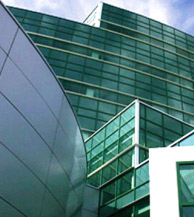CONTACTS
 |
Science for a Better World
Summary of Critical Technological and Health-Related Innovations
Healthcare
LANL is conducting breakthrough research in the treatment of communicable diseases, including AIDS and avian flu, as well as assisting with the Human Genome Project, which began at LANL.
- To Kill a Killer—Targeting Anthrax: Right from the beginning, Los Alamos National Laboratory has been a key participant in the fight against anthrax.
- The Life-Saving Business of Radioisotopes: Spurred on by an invigorated national program, the Lab has plans to develop new radioisotopes for medical diagnostics and therapies. Every month, Los Alamos produces enough radioactive strontium-82 to permit an estimated 6,000 heart diagnoses via PET scans. The Lab is also in the business of producing radioactive products that are used by industry, homeland security, and research.
- Studying West Nile Virus in Birds: Some bird species fall prey to West Nile virus while others are immune. Los Alamos researchers are the first to analyze how a bird’s immune system responds to the disease. But there's a larger picture in the recognition that birds are a reservoir for diseases that can affect humans.
Environment
LANL is directly involved in advancing hydrogen fuel cells to reduce dependence on fossil fuels, as well as developing and mapping key climate change data.
- Synthetic Fuel Concept to Steal Carbon Dioxide From Air: Los Alamos National Laboratory has developed Green Freedom™, a low-risk, transformational concept, for large-scale production of carbon-neutral, sulfur-free fuels and organic chemicals from air and water.
- Predictions of Arctic Climate Change: Los Alamos–based computer models project that by 2040 the Arctic Ocean
may be ice-free for part of each year, bringing devastation to Arctic inhabitants. What makes this projection believable? And does it portend other abrupt
changes in climate?
- Containing Carbon Dioxide: Injecting CO2, the most troublesome greenhouse gas, into porous rock formations beneath the earth might be the best short-term option for slowing global warming. Los Alamos scientists are developing a comprehensive risk assessment program to ensure safe and effective CO2 containment.
- In NATURE - Novel Simulator Shows Earthquakes Have Dangerous Memories: Wave energy stored in granular materials found along fault lines can trigger aftershocks. This research provides insights into how earthquakes can be triggered.
- The Global Energy Challenge: Experts on energy and zero-emission coal and carbon-dioxide sequestration, discuss their ideas on providing clean energy to an energy-hungry world.
Technology
LANL is home to one of the world's fastest supercomputers, Roadrunner™, which can perform 70 trillion calculations per second and provide solutions to the most complex math, science, and physics problems that confront scientific, technological, business, and social advancement.
- Roadrunner site
- Laboratory Wins Awards of Excellence in Technology Transfer: Three Laboratory technologies and staff members won 2008 Federal Laboratory Consortium (FLC) Awards of Excellence in Technology Transfer. Technologies included Attila, High Definition Laser Scanners for Surveying, and Second-Generation High Temperature Superconducting Wire. The FLC is a nationwide network of federal laboratories that links mission technologies with the marketplace. Click on the headline for more information.
- DARHT—A New Hydrotest Facility for Stockpile Stewardship: The Dual Axis Radiographic Hydrotest Facility will house the world's first machine capable of taking x-ray mini-movies of a mock nuclear weapon implosion. Scientists knew that weapons in storage would be damaged over time by their own radioactivity and would need replacement components. But would the replacements function as required? And how could that be checked under the testing moratorium?The answer was to find a way to test without physical testing...
- A Lifelike Machine—Nanomachines mimic living cells Imagine a computer chip that, when damaged, "heals itself" by replicating and making new, undamaged copies of itself.
- Thinking Telescopes—A Discovery Engine for Astronomy: A small but agile robotic-telescope system named RAPTOR surprised the world with its unexpected detection of the early optical light from gamma-ray bursts, the super-energetic cosmic explosions believed to announce the birth of stellar-size black holes. Now RAPTOR is being transformed into a next-generation global network of survey and fast-response telescopes, a pathfinder technology for exploring the dynamic universe in real time and making significant discoveries without human intervention.
- Spotlight: Terrorists Beware, Big City's Life on the Line, Protons, Camera—Action, A Big SCORE, High-Altitude Dowsing
- 1663 Spotlight: Present at the Solar System’s Birth; Unusual Waves; Genie Pro; An MRI for Your Luggage
 |


Nation's #1 Choice
Los Alamos National Laboratory, known as a national center for the science and development of nuclear technology, is now the NNSA's #1 choice for nuclear weapons design, development, and assessment; plutonium research, development, and manufacturing; and supercomputing.
National Security Science Building, Los Alamos National Laboratory
 |



